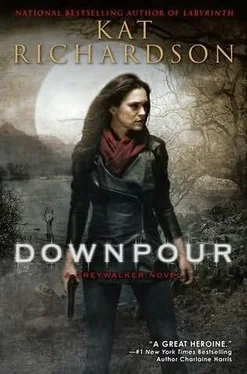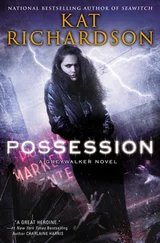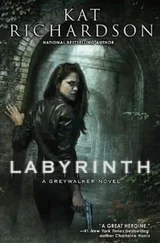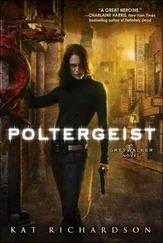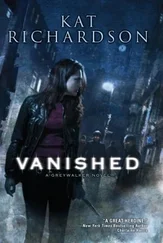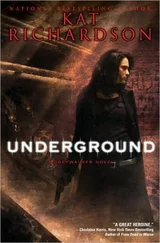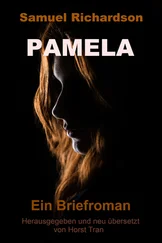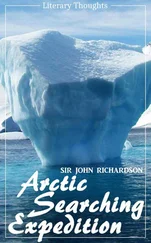“Possibly, depending on the spell and the residue. How big an object are you talking about now?”
“A car.”
“Oh. I’d imagine something that size would take a bit of doing. What sort of spellcraft was it?”
“Well, that’s what I’m not sure of. I didn’t see the setup, but there seemed to be some candles, some designs drawn in powder or herbs or salt, a bowl of water, and a piece off the car. I couldn’t see the spell-caster very well, so I don’t know the sex or race, but he or she had some kind of magical help—like a double or a ghost of some kind—that lent some additional . . . lifting power to the spell near the end. They picked up the metal from the car and dropped it into the bowl of water. It looked like the movement took a lot of energy and was difficult for the magician alone, so the other one pitched in. Once the metal was in the bowl, one of them lit a candle—dark but I couldn’t say what color—that burned down abnormally fast. When they were done, the human one buried the water and the metal in the circle and then smudged out the power symbols. What does that sound like?”
“No blood or body parts?” Mara asked.
“No, I’m glad to say.”
“Well, it’s kitchen magic of some kind.”
“Like . . . what you do when you’re cooking?” I asked, uncertain.
“Oh no. It’s a category of spell work that’s done with herbs, candles, household items.... It’s symbolic and sympathetic: An object stands in for the one you want to effect, and the herbs or powders you use in casting the spell, drawing the symbols, anointing the candles, and so on, influence varying elements and actions in the world. It’s the sort of working that led to alchemy and modern pharmacology. So when your caster moved the bit of the car into the bowl of water, he was moving the car into a body of water—or asking for some spirit to do it for him.”
“So the car’s in a body of water?”
“If the spell worked. And judging by your description of the candle’s burning down, it most likely did. The candle represents work or effort turned to your task—though you should also be looking for the source of that much power as well. Was it a very fat candle?”
I thought about it. “Yes, I think it was. And dark colored.”
“So you said. May have been black, which can mean a lot of things, but certainly it would imply that your caster wanted to obscure something. If he’d wanted to reveal a lost thing, he might have used a white candle instead. D’you see?”
“I think I do. So the fatter the candle, the more effort can be put out?”
“Potentially. If the candle burns out before you’ve got what you wanted done, you can’t just light another; it has to be the same candle—or a lot of them—burning continuously from start to finish of your spell work. The spell-caster in this case needed a lot of energy to move something as heavy as a car. So he used a fat candle and got some help, too.”
“Who or what was the helper? It glowed green and I was pretty sure it wasn’t human—or not a live one at any rate.”
“Green? Could be an elemental or some kind of a loa, though I’m not very versed in Voodoo and such. . . .”
“Voodoo?”
“Don’t make that face I know you’re making. It’s a religion, y’know. They call on spirits, called ‘loa,’ for knowledge and guidance, and the loa speak through human conduits during the ceremony. I don’t know much more about it than that except that there are several related religions with slightly different ceremonies and names. But the spell work—it’s called ‘hoodoo’—is from an even older school and a lot of other practices have adapted it.”
I sighed and picked up Chaos, teasing her with the corner of the blanket. “So this unknown person, using a nonspecific magic and pulling a lot of power from an unknown source, hid the car in the lake.”
“That would be very likely.”
“But which lake? There are two.”
“Which lake is closer to where the spell circle is?”
“They’re both nearby, though one was very close.”
“Hm . . . Which one was the caster facing? Which way did he direct the magic?”
“ Um . . . west.”
“Then it’ll be in the lake to the west.”
“Damn.”
“I take it that’s a problem?”
“Yes. The lake to the west is Lake Crescent. It’s twelve miles long and I don’t know how deep, but pretty deep.”
“Well . . . someone truly didn’t want that car found, did they?”
“No. . . . Not at all. Mara, one more thing . . .”
“Yes?”
“Do you know of any monsters associated with this sort of kitchen magic? Not just the loa.”
“Elementals, I suppose. . . .”
“Any of them look like . . . sort of large, white, horned apes or dogs with hands?”
“Not that I’ve ever seen. Elementals vary, though. They tend to resemble that from which they’re drawn, so a white, horned ape . . . sounds unlikely. At least in the tradition I know. Shall I ask Ben to look through his books?”
“Not right this second,” I replied, thinking of the time I’d spend just waiting on hold while Ben sorted through his collections of myth and legend.
Mara laughed again. “Oh no! Not now, indeed! I’ll have him try after Brian’s gone to sleep, then, shall I?”
“That would be great.”
“It’ll give him an excuse to find some new stories to frighten the boy with. I swear that child has an evil genius for trouble,” she said. “I’m sure I don’t know where it comes from.”
“Oh no?” I asked. “It couldn’t possibly come from having a witch for a mother, a mad paranormal researcher for a father, and growing up in a haunted house?”
“Sha! ’Tisn’t haunted anymore! Except by the boy-beast himself.”
I chuckled at her. Brian did have a talent for raising Cain, but at least it had mostly been of a normal kind. I thanked Mara for her help and disconnected.
Then I sat frowning over the problem of the car in the lake. If the car was or contained evidence of foul play, hiding it in the depths of Lake Crescent would have been attractive. Normally, I’d have thought the use of magic for such a mundane task as moving a car was ridiculous, but if it meant keeping your secrets between yourself and some spirit you controlled, then it didn’t look so utterly wasteful and stupid after all. Even if the wreck had been reported and someone had been sent to look for it on the road, the car would have vanished without a trace—no tire imprints or tow truck records to show how it had disappeared. If the site where I’d seen the image of Leung’s burning car had been the actual scene of the accident, it was only a few dozen yards from Lake Crescent, which teemed with wild power. Even a magical lift wouldn’t have to move it far.
But no matter how it had gotten there, if Leung’s car really was in the big lake, I had no idea how to find it or prove it.
Istarted my morning at the Veela Café once again, using one of their ancient computers to look up some information about Lake Crescent and Lake Sutherland. The ethereal flames of Leung’s presence kept up a dim flickering in the edges of my vision, fading further the longer I delayed. Sometimes the Internet is not your friend when you want to be reassured about the job at hand. The more I read, the more I wished the car had wound up in Lake Sutherland. The smaller lake’s average depth was only 57 feet with a maximum of 86, leaving a possibility of spotting the car, if not of sending divers to it.
Lake Crescent, on the other hand, was huge and its bottom topography mostly unknown. Maximum depth had been given as 624 feet in the 1970s, since that was as deep as the equipment used by the college fisheries project doing the survey could measure. But the depth fell into dispute when a power company had decided to lay cable across the lake. The dropped cable had continued to sink until it hit the equipment’s maximum at 1,000 feet, but it still hadn’t struck the bottom. Since the lake’s surface was at an elevation of 580 feet, the glacially formed lake bottom might lie hundreds of feet below sea level. If Leung’s car was in one of the deep crevices, it was gone forever.
Читать дальше
